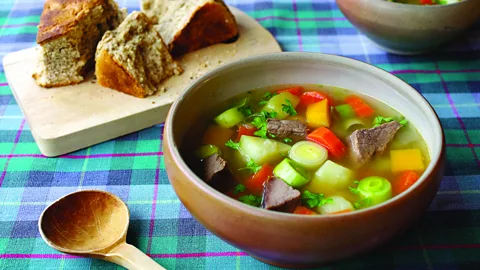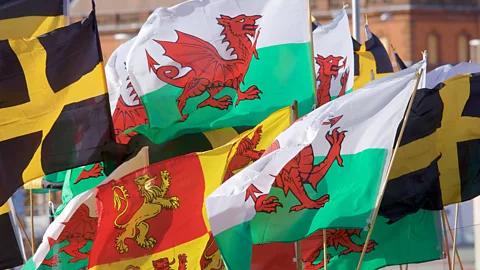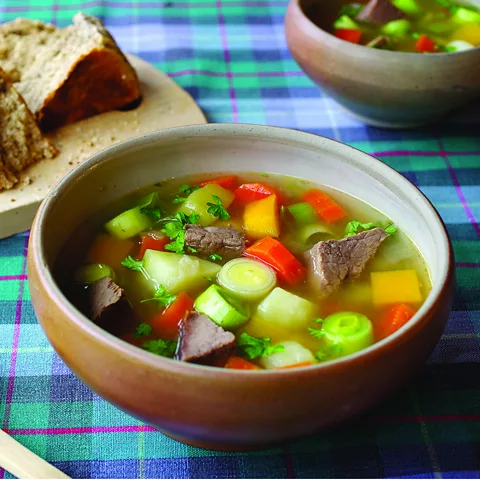Cawl Cymreig: A Welsh stew for St David's Day
 Visit Wales
Visit WalesThe annual celebration to honour the patron Saint of Wales includes cawl, an easy and succulent lamb stew with potatoes and vegetables.
The stew is piping hot. Steam rises from the chunks of tender lamb, potatoes, carrots and swedes (rutabagas) as I dip a slice of crusty bread, liberally spread with salty Welsh butter, into the bowl. Packed with nutritious vegetables and succulent lamb, cawl Cymreig (a traditional slow-cooked stew that translates as "Welsh soup") is hearty, comforting and delicious.
Said to have originated in the 14th Century in Wales, the unofficial national dish was traditionally simmered in a pot on an open fire and served during special occasions. Nowadays you can find the stew on Welsh menus year-round, but it's a staple on St David's Day (celebrated each 1 March), when Celtic nations celebrate the life of the greatest figure in the 6th-Century Welsh Age of Saints: David.
Known as the "spiritual commander-in-chief" of Wales, David was said to have been born in 500AD and was the grandson of Ceredig ap Cunedda, the king of the western Welsh territory of Ceredigion. David grew up to become a preacher of repute, founding numerous churches and monastic settlements. The saint, who followed an austere life and shunned meat and beer, is rumoured to have subsisted on leeks and water (this may be why the leek became a national symbol of Wales).
During the Middle Ages, pilgrims travelled to St David's cathedral in Haverfordwest, Wales, to pray to the saint and seek blessings. In 1123, Pope Callixtus II in Rome declared that two pilgrimages to the cathedral were equal to one journey to Rome. The spectacular, purple-stoned cathedral is now the religious centre of Wales.
On 1 March (the day David died), the patron saint is honoured with decorations, buntings, singing, dancing and much eating. Every feast, whether in a fancy restaurant, small pub or family home, includes the stew.
"Cawl is always served on St David's Day, although we eat it at other times as well. It's a firm favourite during the winter months, eaten with chunks of homemade bread and Welsh cheese," said TV chef and food consultant Nerys Howell, who is the author of the book Welsh Food by Season.
"The hearty dish is made of meat [typically lamb or beef] and any available vegetables. Recipes are often handed down through the family and vary from town to town, season to season, throughout Wales," she said.
The hallmark of Welsh cuisine is that it is the food of the country's farmers, miners, peasants and others. "Welsh food is the cooking of the ordinary folk of Wales. We have our own unique culture with recipes based on good quality, wholesome, seasonal produce and regional varieties," Howell said.
 David Williams/Getty
David Williams/GettyThe country's ingredients reflect its geography: meat and dairy from the hilly pastures; cockles, clams, and mackerel from the sea; root vegetables and leeks from the fields; cereals from the farms; and salmon and sewin (Welsh sea trout) from the rivers.
Sian Roberts, founder of culinary tour company Loving Welsh Food, agrees that Wales does not have a tradition of haute cuisine. "Our recipes, handed down for generations, are cooked using basic cooking methods. A country's cuisine depends on geography, climate and cooking equipment. Most people in Wales didn't have an oven so they cooked over an open fire. We have lots of recipes cooked in saucepans or cauldrons and on the griddle (bread, cakes and biscuits)."
Thrifty homemakers followed a nose-to-tail philosophy to eke out meals from every bit of meat and produce, balancing their lifestyle and pocket. The neck of the lamb – typically not used in other dishes – was used to create a stew that was healthy, tasty and economical. And despite the fact that David himself may have only eaten leeks, traditional versions of the stew often include meat.
"The use of cheap cawl cuts of meat for the recipe probably had more to do with the fact that families could not afford the most expensive cuts, as cawl was a peasant food," Howell said. "Even today, the cheapest cuts of meat are the best, as this dish takes long, slow cooking and the meat will melt in your mouth. It is best cooked the day before so you can skim off any fat the next day."
St David is often remembered for his famous last words: "Be joyful, keep the faith, and do the little things that you have heard and seen me do." The phrase Gwnewch y pethau bychain mewn bywyd ("Do the little things in life") is a well-known maxim in Wales.
On his day, it seems fitting to make a dish with "the little things" – a stew that showcases the resourceful, wholesome and practical nature of the Welsh people.
 Visit Wales
Visit WalesServes 6
Ingredients
1kg middle neck or shoulder Welsh lamb, Welsh beef or ham hock
1 onion, roughly chopped
6 medium potatoes, peeled and chopped
3 carrots, peeled and chopped
1 small swede (rutabaga) or 2 parsnips, peeled and chopped
vegetable stock
salt and pepper
2 leeks, washed and sliced
1 small bunch fresh parsley, roughly chopped
Method
Step 1
Place the meat in a large saucepan, add the onion, cover with water and bring to the boil. Cover and simmer for 2-3 hours over a low heat. Leave overnight to cool in the fridge and the following day skim off any fat that has risen to the surface.
Step 2
Cut the meat off the bone and return to the saucepan. Add the potatoes, carrots, swede (or parsnips) and simmer until cooked through. Add vegetable stock if required. Season with salt and pepper.
Step 3
Finally add the sliced leeks and just before serving, throw in the chopped parsley. If needed, you can thicken the cawl by whisking in fine oatmeal or a paste of flour and water.
Note
It is better to use a cheaper cut of meat on the bone so that maximum flavour is obtained. You can also serve the meat separately to the vegetable soup.
BBC.com's World's Table "smashes the kitchen ceiling" by changing the way the world thinks about food, through the past, present and future.
---
If you liked this story, sign up for The Essential List newsletter – a handpicked selection of features, videos and can't-miss news delivered to your inbox every Friday.
